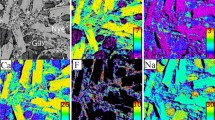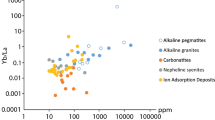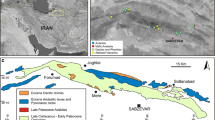Abstract
Trace element partitioning between minerals and liquids provides crucial constraints on igneous processes. We quantified trace element concentrations in clinopyroxene (Cpx) phenocrysts and their phonolite melt inclusions from the 2007–08 eruption of Oldoinyo Lengai (Tanzania), and report Cpx-melt partition coefficients (D) and corresponding partitioning equations for rare earth elements (REE) and high field strength elements (HFSE) in alkaline magmas. Heavy REE (HREE: Er, Tm, Yb, Lu) are enriched relative to middle REE in alkaline Cpx and display a specific partitioning behavior that is characteristic of alkaline systems. HFSE (Ti, Zr, Hf) and HREE have similar D values (DHf = 0.25; DLu = 0.4) that are significantly higher than MREE (DSm = 0.06). High DHREE/DMREE are strongly correlated with the high values of DZr and DHf relative to the low DMREE values. In this study, REE partitioning between phonolite melt and Cpx is not consistent with standard models assuming incorporation of all REE in the Cpx M2 site, but rather highlights HREE substitution in both the M1 and M2 sites. Here we highlight the preferential incorporation of HREE in the VI-coordinated M1 site, whereas light REE and MREE remain mostly distributed in the VIII-coordinated M2 site. REE partitioning is strongly dependent on Cpx chemistry: the ideal ionic radius and HREE incorporation in the M1 site increase with increasing Fe3+ content and decrease with increasing Mg2+ and AlVI content. In our study, we focus on alkaline evolved magmas, and update existing models to obtain adequate DHREE for alkaline evolved melts. We provide equations to quantify REE and HFSE partitioning, and HREE enrichment in Cpx that are based on Cpx major element composition and temperature. We propose a new model based on the lattice strain approach that predicts HREE partitioning between Cpx and alkaline magmas. The knowledge of the melt composition or of the trace element contents is not required to obtain DREE from the new model. An improved parameterization of HFSE partitioning between Cpx and phonolite and trachy–phonolite melts is also provided herein. We discuss the potential implications of the new data on our understanding of REE deposits that are commonly associated with igneous alkaline complexes.














Similar content being viewed by others
References
Adam J, Green T (2006) Trace element partitioning between mica-and amphibole-bearing garnet lherzolite and hydrous basanitic melt: 1. Experimental results and the investigation of controls on partitioning behaviour. Contrib. Mineral. Petrol. 152(1):1–17
Batki A, Pál-Molnár E, Jankovics MÉ, Kerr AC, Kiss B, Markl G, Heincz A, Harangi S (2018) Insights into the evolution of an alkaline magmatic system: an in situ trace element study of clinopyroxenes from the Ditrău Alkaline Massif, Romania. Lithos 300:51–71. https://doi.org/10.1016/j.lithos.2017.11.029
Baudouin C, France L (2019) Trace element partitioning between wollastonite and alkaline silicate magmas. Chem Geol 523:88–94
Baudouin C, Parat F (2015) Role of volatiles (S, Cl, H2O) and silica activity on the crystallization of haüyne and nosean in phonolitic magmas (Eifel, Germany and Saghro, Morocco). Am Miner 100(10):2308–2322. https://doi.org/10.2138/am-2015-5318
Baudouin C, Parat F, Denis CM, Mangasini F (2016) Nephelinite lavas at early stage of rift initiation (Hanang volcano, North Tanzanian Divergence). Contrib Mineral Petrol 171(7):64. https://doi.org/10.1007/s00410-016-1273-5
Beard CD, van Hinsberg VJ, Stix J, Wilke M (2019) Clinopyroxene/melt trace element partitioning in sodic alkaline magmas. J Petrol 60:1797-1823
Bédard JH (2014) Parameterizations of calcic clinopyroxene—melt trace element partition coefficients. Geochem Geophys Geosyst 15(2):303–336
Bennett SL, Blundy J, Elliott T (2004) The effect of sodium and titanium on crystal-melt partitioning of trace elements. Geochim Cosmochim Acta 68(10):2335–2347. https://doi.org/10.1016/j.gca.2003.11.006
Blundy J, Wood B (1994) Prediction of crystal–melt partition coefficients from elastic moduli. Nature 372(6505):452
Blundy J, Wood B (2003) Partitioning of trace elements between crystals and melts. Earth Planet Sci Lett 210(3–4):383–397. https://doi.org/10.1016/S0012-821X(03)00129-8
Blundy JD, Robinson JAC, Wood BJ (1998) Heavy REE are compatible in clinopyroxene on the spinel lherzolite solidus. Earth Planet Sci Lett 160(3):493–504. https://doi.org/10.1016/S0012-821X(98)00106-X
Bottazzi P, Tiepolo M, Vannucci R, Zanetti A, Brumm R, Foley SF, Oberti R (1999) Distinct site preferences for heavy and light REE in amphibole and the prediction of Amph/L D REE. Contrib Mineral Petrol 137(1–2):36–45
Braunger S, Marks MAW, Walter BF, Neubauer R, Reich R, Wenzel T, Markl G (2018) The petrology of the Kaiserstuhl Volcanic Complex, SW Germany: the importance of metasomatized and oxidized lithospheric mantle for carbonatite generation. J Petrol 59(9):1731–1762
Brice JC (1975) Some thermodynamic aspects of the growth of strained crystals. J Cryst Growth 28(2):249–253. https://doi.org/10.1016/0022-0248(75)90241-9
Cameron M, Papike JJ (1980) Crystal chemistry of silicate pyroxenes. Rev Mineral Geochem 7(1):5–92
Dalou C, Koga KT, Shimizu N, Boulon J, Devidal JL (2012) Experimental determination of F and Cl partitioning between lherzolite and basaltic melt. Contrib Mineral Petrol 163(4):591–609. https://doi.org/10.1007/s00410-011-0688-2
Dalou C, Boulon J, Koga KT, Dalou R, Dennen R (2018) DOUBLE FIT: optimization procedure applied to lattice strain model. Comput Geosci 117:49–56
Dawson JB (1998) Peralkaline nephelinite–natrocarbonatite relationships at Oldoinyo Lengai. Tanzania J Petrol 39(11–12):2077–2094. https://doi.org/10.1093/petroj/39.11-12.2077
de Moor JM, Fischer TP, King PL, Botcharnikov RE, Hervig RL, Hilton DR, Ramirez C (2013) Volatile-rich silicate melts from Oldoinyo Lengai volcano (Tanzania): Implications for carbonatite genesis and eruptive behavior. Earth Planet Sci Lett 361:379–390
Droop GTR (1987) A general equation for estimating Fe3+ concentrations in ferromagnesian silicates and oxides from microprobe analyses, using stoichiometric criteria. Mineral Mag 51(361):431–435
Dygert N, Liang Y, Sun C, Hess P (2014) An experimental study of trace element partitioning between augite and Fe-rich basalts. Geochim Cosmochim Acta 132:170–186. https://doi.org/10.1016/j.gca.2014.01.042
Fedele L, Zanetti A, Morra V, Lustrino M, Melluso L, Vannucci R (2009) Clinopyroxene/liquid trace element partitioning in natural trachyte–trachyphonolite systems: insights from Campi Flegrei (southern Italy). Contrib Mineral Petrol 158(3):337–356. https://doi.org/10.1007/s00410-009-0386-5
Gaetani GA (2004) The influence of melt structure on trace element partitioning near the peridotite solidus. Contrib Mineral Petrol 147(5):511–527
Gaetani GA, Grove TL (1995) Partitioning of rare earth elements between clinopyroxene and silicate melt crystal-chemical controls. Geochim Cosmochim Acta 59(10):1951–1962. https://doi.org/10.1016/0016-7037(95)00119-0
Griffin WL, Powell W, Pearson NJ, O'Reilly SY (2008) GLITTER: data reduction software for laser ablation ICP–MS. Laser Ablation–ICP–MS in the Earth Sciences vol. 40. Mineralogical Association of Canada Short Course Series, pp. 204–207
Hill E, Wood BJ, Blundy JD (2000) The effect of Ca-Tschermaks component on trace element partitioning between clinopyroxene and silicate melt. Lithos 53(3):203–215. https://doi.org/10.1016/S0024-4937(00)00025-6
Hill E, Blundy JD, Wood BJ (2011) Clinopyroxene–melt trace element partitioning and the development of a predictive model for HFSE and Sc. Contrib. Mineral. Petrol. 161(3):423–438. https://doi.org/10.1007/s00410-010-0540-0
Hornig-Kjarsgaard I (1998) Rare earth elements in sövitic carbonatites and their mineral phases. J Petrol 39(11–12):2105–2121
Huang F, Lundstrom CC, McDonough WF (2006) Effect of melt structure on trace-element partitioning between clinopyroxene and silicic, alkaline, aluminous melts. Am Miner 91(8–9):1385–1400. https://doi.org/10.2138/am.2006.1909
Keller J, Kraft M (1990) Effusive natrocarbonatite activity of Oldoinyo Lengai, June 1988. Bull Volcanol 52(8):629–645
Lundstrom CC, Shaw HF, Ryerson FJ, Phinney DL, Gill JB, Williams Q (1994) Compositional controls on the partitioning of U, Th, Ba, Pb, Sr and Zr between clinopyroxene and haplobasaltic melts: implications for uranium series disequilibria in basalts. Earth Planet Sci Lett 128(3–4):407–423
Marks M, Halama R, Wenzel T, Markl G (2004) Trace element variations in clinopyroxene and amphibole from alkaline to peralkaline syenites and granites: implications for mineral–melt trace-element partitioning. Chem Geol 211(3):185–215. https://doi.org/10.1016/j.chemgeo.2004.06.032
Martin LH, Schmidt MW, Mattsson HB, Guenther D (2013) Element partitioning between immiscible carbonatite and silicate melts for dry and H2O-bearing systems at 1–3 GPa. J Petrol 54(11):2301–2338
Masotta M, Mollo S, Freda C, Gaeta M, Moore G (2013) Clinopyroxene–liquid thermometers and barometers specific to alkaline differentiated magmas. Contrib Miner Petrol 166(6):1545–1561. https://doi.org/10.1007/s00410-013-0927-9
McDonough WF, Sun SS (1995) The composition of the Earth. Chem Geol 120(3–4):223–253
Michely LT, Leitzke FP, Speelmanns IM, Fonseca ROC (2017) Competing effects of crystal chemistry and silicate melt composition on trace element behavior in magmatic systems: insights from crystal/silicate melt partitioning of the REE, HFSE, Sn, In, Ga, Ba, Pt and Rh. Contrib Miner Petrol 172(6):39
Möller V, Williams-Jones AE (2016) Petrogenesis of the Nechalacho Layered Suite, Canada: magmatic evolution of a REE–Nb-rich nepheline syenite intrusion. J Petrol 57(2):229–276. https://doi.org/10.1093/petrology/egw003
Mollex G (2017) Architecture de la plomberie du volcan carbonatitique Oldoinyo Lengai: nouvelles contraintes sur la source, les transferts hydrothermaux, et la différenciation magmatique dans la chambre active, PhD thesis, Université de Lorraine
Mollex G, Füri E, Burnard P, Zimmermann L, Chazot G, Kazimoto EO, Marty B, France L (2018) Tracing helium isotope compositions from mantle source to fumaroles at Oldoinyo Lengai volcano. Tanzania Chemical Geology 480(5):66–74
Mollo S, Putirka K, Misiti V, Soligo M, Scarlato P (2013) A new test for equilibrium based on clinopyroxene-melt pairs: clues on the solidification temperatures of Etnean alkaline melts at post eruptive conditions. Chem Geol 352:92–100. https://doi.org/10.1016/j.chemgeo.2013.05.026
Mollo S, Forni F, Bachmann O, Blundy JD, De Astis G, Scarlato P (2016) Trace element partitioning between clinopyroxene and trachy-phonolitic melts: a case study from the Campanian Ignimbrite (Campi Flegrei, Italy). Lithos 252:160–172. https://doi.org/10.1016/j.lithos.2016.02.024
Mollo S, Blundy J, Scarlato P, De Cristofaro SP, Tecchiato V, Di Stefano F, VetereBachmann O (2018) An integrated P-T-H2O-lattice strain model to quantify the role of clinopyroxene fractionation on REE+ Y and HFSE patterns of mafic alkaline magmas: Application to eruptions at Mt. Etna Earth-Sci Rev 185:32–56
Morimoto N (1988) Nomenclature of pyroxenes. Mineral Petrol 39(1):55–76
Nagasawa H (1966) Trace element partition coefficient in ionic crystals. Science 152(3723):767–769
Olin PH, Wolff JA (2010) Rare earth and high field strength element partitioning between iron-rich clinopyroxenes and felsic liquids. Contrib Mineral Petrol 160(5):761–775. https://doi.org/10.1007/s00410-010-0506-2
Onuma N, Higuchi H, Wakita H, Nagasawa H (1968) Trace element partition between two pyroxenes and the host lava. Earth Planet Sci Lett 5:47–51. https://doi.org/10.1016/S0012-821X(68)80010-X
Reguir EP, Chakhmouradian AR, Pisiak L, Halden NM, Yang P, Xu C, Kynicky J, Couëslan CG (2012) Trace-element composition and zoning in clinopyroxene-and amphibole-group minerals: implications for element partitioning and evolution of carbonatites. Lithos 128:27–45. https://doi.org/10.1016/j.lithos.2011.10.003
Shannon RD (1976) Revised effective ionic radii and systematic studies of interatomic distances in halides and chalcogenides. Acta Crystallogr A 32(5):751–767
Vuorinen JH, Hålenius U, Whitehouse MJ, Mansfeld J, Skelton AD (2005) Compositional variations (major and trace elements) of clinopyroxene and Ti-andradite from pyroxenite, ijolite and nepheline syenite, Alnö Island, Sweden. Lithos 81(1–4):55–77. https://doi.org/10.1016/j.lithos.2004.09.021
Weidendorfer D, Schmidt MW, Mattsson HB (2016) Fractional crystallization of Si-undersaturated alkaline magmas leading to unmixing of carbonatites on Brava Island (Cape Verde) and a general model of carbonatite genesis in alkaline magma suites. Contrib Mineral Petrol 171(5):43. https://doi.org/10.1007/s00410-016-1249-5
Wood BJ, Blundy JD (1997) A predictive model for rare earth element partitioning between clinopyroxene and anhydrous silicate melt. Contrib Mineral Petrol 129(2–3):166–181
Wood BJ, Blundy JD (2001) The effect of cation charge on crystal–melt partitioning of trace elements. Earth Planet Sci Lett 188(1–2):59–71
Wood BJ, Blundy JD (2007) Trace element partitioning under crustal and uppermost mantle conditions: the influences of ionic radius, cation charge, pressure, and temperature. Treatise Geochem 2:568
Woodland AB, Jugo PJ (2007) A complex magmatic system beneath the Deves volcanic field, Massif Central, France: evidence from clinopyroxene megacrysts. Contrib Miner Petrol 153(6):719–731
Yang XM, Yang XY, Chen TH, Zhang PS, Tao KJ, Le Bas MJ, Henderson P (2000) Geochemical characteristics of a carbonatite dyke rich in rare earths from Bayan Obo, China
Zhang C, Koepke J, France L, Godard M (1256D) Felsic plutonic rocks from IODP Hole 1256D, Eastern Pacific: implications for the nature of the axial melt lens at fast-spreading mid-ocean ridges. J Petrol 58(8):1535–1565. https://doi.org/10.1093/petrology/egx064
Acknowledgements
We thank C. Beard, P. Ulmer, D. Weidendorfer, and 2 anonymous reviewers for their useful comments. We also thank the Tanzania commission for science and technology (COSTECH) for the field permits. The authors acknowledge the help of Robert Dennen for English editing. This research was financially supported by the French National Research Agency through the national program “Investissements d'avenir” with the reference ANR-10-LABX-21 01/LABEX RESSOURCES21, and through the project GECO-REE (ANR-16-CE01-0003-01; P.I.: Lydéric France). This study has also been supported by the Région Lorraine, and Région Grand-Est, and PNP and CESSUR programs from INSU-CNRS (grants to Lydéric France). This is CRPG contribution n° 2999, and GECO-REE contribution n° 03.
Author information
Authors and Affiliations
Corresponding author
Additional information
Communicated by Othmar Müntener.
Publisher's Note
Springer Nature remains neutral with regard to jurisdictional claims in published maps and institutional affiliations.
Electronic supplementary material
Below is the link to the electronic supplementary material.
Rights and permissions
About this article
Cite this article
Baudouin, C., France, L., Boulanger, M. et al. Trace element partitioning between clinopyroxene and alkaline magmas: parametrization and role of M1 site on HREE enrichment in clinopyroxenes. Contrib Mineral Petrol 175, 42 (2020). https://doi.org/10.1007/s00410-020-01680-6
Received:
Accepted:
Published:
DOI: https://doi.org/10.1007/s00410-020-01680-6




